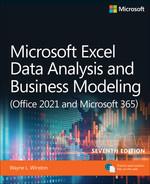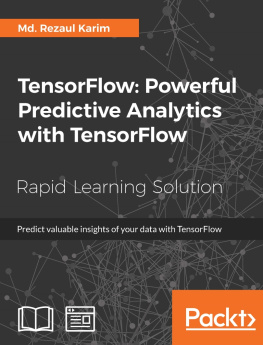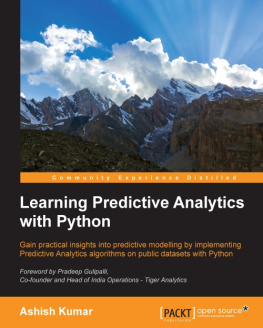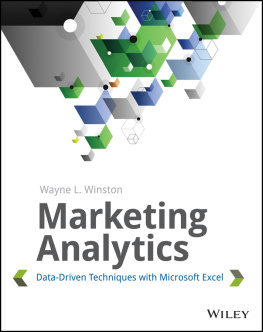Carlberg C. - More Predictive Analytics. Microsoft Excel
Here you can read online Carlberg C. - More Predictive Analytics. Microsoft Excel full text of the book (entire story) in english for free. Download pdf and epub, get meaning, cover and reviews about this ebook. genre: Science. Description of the work, (preface) as well as reviews are available. Best literature library LitArk.com created for fans of good reading and offers a wide selection of genres:
Romance novel
Science fiction
Adventure
Detective
Science
History
Home and family
Prose
Art
Politics
Computer
Non-fiction
Religion
Business
Children
Humor
Choose a favorite category and find really read worthwhile books. Enjoy immersion in the world of imagination, feel the emotions of the characters or learn something new for yourself, make an fascinating discovery.

- Book:More Predictive Analytics. Microsoft Excel
- Author:
- Genre:
- Rating:3 / 5
- Favourites:Add to favourites
- Your mark:
More Predictive Analytics. Microsoft Excel: summary, description and annotation
We offer to read an annotation, description, summary or preface (depends on what the author of the book "More Predictive Analytics. Microsoft Excel" wrote himself). If you haven't found the necessary information about the book — write in the comments, we will try to find it.
Accurate, practical Excel predictive analysis: powerful smoothing techniques for serious data crunchers!In More Predictive Analytics, Microsoft Excel MVP Conrad Carlberg shows how to use intuitive smoothing techniques to make remarkably accurate predictions. You wont have to write a line of code-all you need is Excel and this all-new, crystal-clear tutorial.Carlberg goes beyond his highly-praised Predictive Analytics, introducing proven methods for creating more specific, actionable forecasts. Youll learn how to predict what customers will spend on a given product next year project how many patients your hospital will admit next quarter tease out the effects of seasonality (or patterns that recur over a day, year, or any other period) distinguish real trends from mere noise.Drawing on more than 20 years of experience, Carlberg helps you master powerful techniques such as autocorrelation, differencing, Holt-Winters, backcasting, polynomial regression, exponential smoothing, and multiplicative modeling.Step by step, youll learn how to make the most of built-in Excel tools to gain far deeper insights from your data. To help you get better results faster, Carlberg provides downloadable Excel workbooks you can easily adapt for your own projects.If youre ready to make better forecasts for better decision-making, youre ready for More Predictive Analytics.Discover when and how to use smoothing instead of regression.
Test your data for trends and seasonality.
Compare sets of observations with the autocorrelation function.
Analyze trended time series with Excels Solver and Analysis ToolPak.
Use Holts linear exponential smoothing to forecast the next level and trend, and extend forecasts further into the future.
Initialize your forecasts with a solid baseline.
Improve your initial forecasts with backcasting and optimization.
Fully reflect simple or complex seasonal patterns in your forecasts.
Account for sudden, unexpected changes in trends, from fads to new viral infections.
Use range names to control complex forecasting models more easily.
Compare additive and multiplicative models, and use the right model for each task. iPAD Amazon Kindle, PC , Cool Reader (EPUB), Calibre (EPUB, MOBI, AZW3), Adobe Digital Editions (EPUB), FBReader (EPUB, MOBI, AZW3).
Carlberg C.: author's other books
Who wrote More Predictive Analytics. Microsoft Excel? Find out the surname, the name of the author of the book and a list of all author's works by series.







